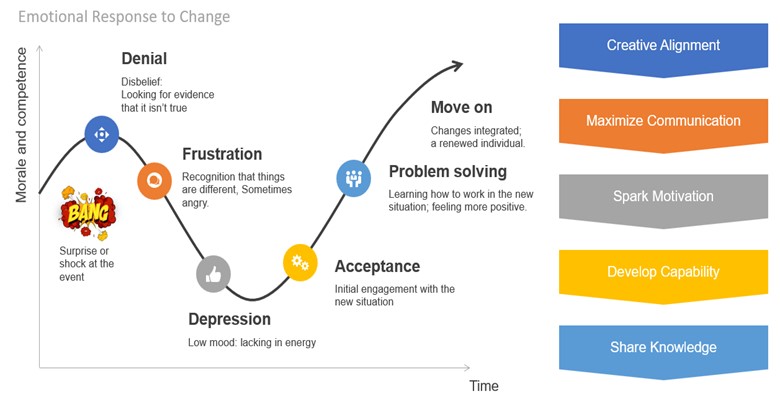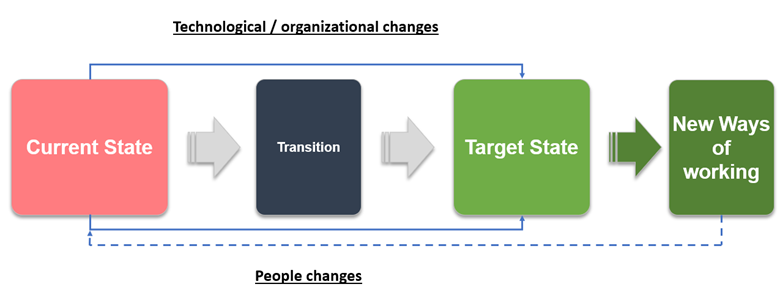A quick overview on how our brain works when facing changes.

I thoroughly enjoyed ITB Berlin this year. The content of many workshops and sessions organized during the conference were very relevant to what is happening in the market and it was great to see so many (happy) colleagues again!
Attending ITB this year put me thinking about a year ago when I missed it… Winter 2022/2023 recorded a peak in ski injuries in the Alpes. Unfortunately back in March last year I did contribute to it by breaking my knee which needed serious surgery. My first reaction to the initial shock (let’s call it “bang”) was to deny it… Then my frustration kicked in by blaming myself (no one else to blame here, I fell on my own!); when the post-surgery recovery “journey” was shared by the doctor, I got totally depressed… What now? At least 3 months before putting the foot on the ground and at least 6 before walking without crutches again? Are you serious? My world literally collapsed, and it took me some time to get out of the “valley” state and move on.
However after a year (!), here I am, attending ITB, cycling and hiking again and planning my next outdoor activities for the summer.
Emotional responses to any change in private and professional life are totally human and everyone consciously (or not) goes through the same phases. Back in 2019 when I first studied the Kuebler-Ross curve during my ICF Coaching Certification in Milan I was immediately fascinated by the theory simply because it reflects how our brain reacts to a “bang”, being this big or small. When in 2022 I revisited the theory during my certification as Change Manager at the Change Management Institute (CMI) I realized once again how true it is.
Here a quick overview of the theory on the emotional response to a change, with some “actionable insight” to face each of the phases of the curve, applicable to your private and professional life:

Let’s stick into our professional life for now. The change is a journey in itself, regardless of whether this was undertaken voluntarily or dictated by external factors outside our control (think about market conditions).
A practical example in the hospitality industry might be when hotels in their digitalization process decide to acquire a Revenue Management System (RMS) moving from a (semi)manual to a (fully)automated operating environment with all consequences in terms of ways of working and people skills required; another practical example might be when a new commercial structure is needed at hotel or corporate level to foster the convergence between Sales, (Digital) Marketing, Distribution and Revenue Management by aligning KPI’s and breaking the silo’s between revenue generating departments.
In essence every journey has a “starting point”, a “transition time” and an “end point”. Supporting people and companies in their transition phase when moving from a “current state” to a “target state” gives me a high level of gratitude; it always feels a privilege to actively contribute to the growth of people and companies by instilling new, sustainable business strategies.
While it is easy to “buy” technology or to re-think an ideal organizational structure, the biggest challenge in most if not all cases lies in the people and in the way they will embrace the change and adopt their new ways of working introduced by the change.

In a nutshell this is what makes the difference between Project Management and Change Management: while Project Management focuses merely on implementation of a new piece of technology including training activities for example, Change Management focuses on the human side of it, on how to prepare and evaluate the impact of the change on people who will need to adapt their way of working to make sure that the return on the investment is optimized.
Going back to the Kuebler-Ross… any change will inevitably unlock an emotional response and the brain will automatically follow the phases similar to the ones illustrated in the curve.
It might take weeks or months or years to move from the “valley” to start looking at the “peak” again. By experience though what really makes the difference in any (sustainable) change is the speed at which you move from one step to another, from a personal and professional point of view.
It’s by knowing, anticipating and structuring each of the phase that you can accelerate the transition from one stage to another, reaching the “move-on” stage much faster by capitalizing much earlier on the change. Think about the necessity to recognize and articulate the why’s of the change, how to communicate and how to involve and actively engage with your main stakeholders. Knowing how to anticipate and accelerate the phases will facilitate a problem-solving approach to the change.
While in theory it seems all simple, it might be very hard in practice as I constantly experience when talking to people, regardless their industry…
“Change is the only constant in life” once said the Greek philosopher Heraclitus…
Change is an “attitude” not a one-off event and knowing the emotional response attached to it and how to accelerate the different phases will improve your private and professional life.